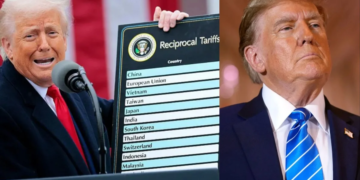Canada has been on edge ever since US President Donald Trump assumed office in January. With Trump’s attempt to incorporate Canada into the country as its 51st state and the high tariffs on imports, US-Canada tariff relations have become a situation stickier than maple syrup.
Trump’s Tacky Tariff Board
April 2, 2025, was a windy day. Trump, clad in his signature tailored suit and proud MAGA smile (to no one else’s amusement), walked out onto the podium carrying a small board with a long list of countries and numbers. Reading off names like a detention teacher, Trump announced several high tariffs on countries like Vietnam (46%), China (34%), India (26%), and even a small island off the coast of Antarctica. Introduced to balance out the trade deficit (amounting to 1.2 trillion dollars), the incredibly high rates bear more likeness to punishments. These reciprocal tariffs simply seem like a petty idea of revenge on the other countries of the world.
Why Is Canada Tariff Percentage Not on Trump’s List?

In 1997, the IEEPA (International Emergency Economic Power Act) was passed in the White House. Due to this act, both Mexico and Canada have been exempted from Trump’s recent ‘Liberation Day’ parade. Saved from the wrath of Wednesday’s announcement of steep reciprocal tariffs, all goods compliant under the existing USMCA (US-Mexico-Canada Act) will face no tariffs including the baseline 10% on imports. Canada doesn’t get to breathe a sigh of relief just yet because all non-compliant goods, however, face a 25% tariff.
How Does Canada Respond?
On Thursday, Canadian PM Mike Carney declared Canada’s retaliation to the US duties with a tariff of 25% on some auto parts and vehicles. Vehicles that are not compliant with the USMCA will face tariffs. Quoting that Trump’s decisions would ‘rupture the global economy’, Carney believes that Trump will not reverse his policy until the US openly and evidently shows the inevitable ill effects of this plan. Carney also stated, ‘I don’t want to give false hope’. Trump tried to justify his tariffs by claiming that the US annually supports Canada with 200 billion dollars, a false statement. “The system of global trade anchored in the United States that Canada has relied on since the end of the Second World War is over,” Carney quoted, calling the entire situation a ‘tragedy’. Even before Carney assumed office, ex-PM Justin Trudeau called Trump’s trade war a ‘dumb thing to do’.
As the first country to retaliate with its own tariffs following Trump’s announcement, Canada may pave the way for other countries to follow suit.
How Has Canada Tariff Been Affected?
Although exempted from Trump’s Liberation Day madness, Canada faces the disadvantages of heavy duties imposed upon its goods. The workers of Canada are majorly dealing with this blow. In fact, Stellantis, an auto manufacturer informed its local union after the announcement on Wednesday that it would be shutting down its Windsor assembly plant for two weeks. A few thousand people were out of work due to this development. PM Carney expressed his support for the workers in his speech on Trump’s tariffs, saying that his government ‘stands in solidarity’ with them. Already having taken this hit, Canada must gear up to take more punches during the course of the next few years.
What Should the World Expect?
The world is currently teetering on the edge of a cliff, inches away from plummeting into an all-out global trade war. Trump’s tariffs could lead to the economies of many small income countries, which have among the highest rates, to collapse. In a pandemic, markets all around the planet are in danger. Small producers and businessmen are already pulling their hair out in stress.
Important goods like vehicles are under the threat of a sharp incline in price, with many economists worried about predicted price hikes. Even daily groceries will become more expensive causing the tariffs’ effects to be at the grassroots level. Not only has the US doomed foreign countries through this extreme move, but it has also affected itself. With either increased inflation (noting that Trump promised to reduce the existing inflation) or a complete slowdown of the economy predicted by expert analysts, the US’s own future looks bleaker than a Canadian winter.















Discussion about this post